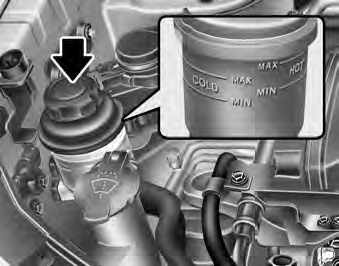Power steering

Checking the power steering
fluid level
With the vehicle on level ground,
check the fluid level in the power
steering reservoir periodically. The
fluid should be between MAX and
MIN marks on the side of the reservoir
at the normal temperature.
Before adding power steering fluid, thoroughly clean the area around the reservoir cap to prevent power steering fluid contamination.
If the level is low, add fluid to the MAX level.
In the event the power steering system requires frequent addition of fluid, the vehicle should be inspected by an Authorized Kia Dealer.
NOTICE
• To avoid damage to the power
steering pump, do not operate the
vehicle for prolonged periods with
a low power steering fluid level.
• Never start the engine when the reservoir tank is empty.
• When adding fluid, be careful that dirt does not get into the tank.
• Too little fluid can make the steering wheel heavier or strange noise can be generated.
• The use of the non-specified fluid could reduce the effectiveness of the power steering wheel and cause damage to it.
Use only the specified power steering
fluid. (Refer to "Recommended lubricants
and capacities" in section 8.)
Power steering hose
Check the connections for oil leaks,
severe damage and the twists in the
power steering hose before driving.
See also:
Label information
There are several important labels
and identification numbers located
on your vehicle. The label locations
are identified in the illustrations
shown.
Vehicle identification number
(VIN)
To chec ...
2009 Kia Optima / Magentis
At first glance the redesigned 2009 Kia Optima (sold in Canada as the
Magentis) looks like a marked improvement over the outgoing model.
The design itself, while not exactly breathtaking, is on pa ...
Cruise control system
The cruise control system allows you to
program the vehicle to maintain a constant
speed without resting your foot on
the accelerator pedal.
This system is designed to function
above approximatel ...


